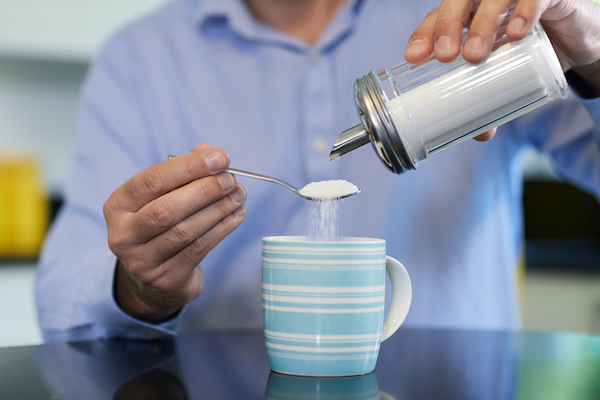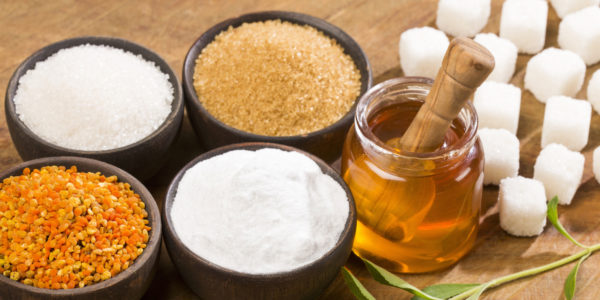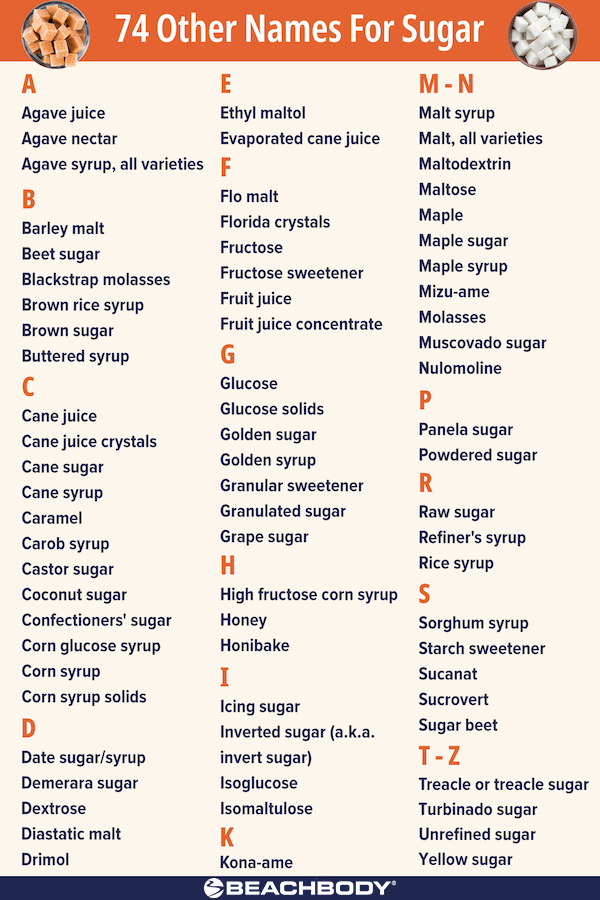- There are many different names for sugar, which can make it difficult to cut added sugar from your diet.
- Reducing your added-sugar intake can be beneficial for your health, and may even help with weight loss.
- Here are 71 names for sugar that you should look for on nutrition labels.
We eat a lot of sugar — more than most of us realize. And while we know to limit sweet treats like candy and ice cream, sugar is also hidden in some surprising foods — like bread, almond milk, and even salad dressing.
That’s because there are so many names for sugar — some you might not even recognize as sugar.
“Yes, sugar hides in plain view,” says Dr. Whitney Bowe, in Sugar Free 3.
“And it may be called something other than ‘sugar,’” she says. “Cane sugar, sucrose, fructose, agave nectar, high fructose corn syrup — but sugar is sugar, no matter how you spell it. There are more than sixty different names for sugar!”
How can you cut back on sugar if you don’t even recognize it on a nutrition label? Here’s what you need to know about these other names for sugar so you can make more informed eating choices.
Think you already know your sugar handles? Before you read on, test your knowledge and see how many sneaky sugars you can identify!
What Is Added Sugar?
Before we get into the other names for sugar, we first have to differentiate between the two major ways we get it in our diet — a.k.a. natural sugar and added sugar.
“Fruits and grains have a naturally occurring sugar which comes with fiber, vitamins, and minerals,” says Emily Tills, MS, RDN, CDN, a registered dietitian nutritionist in Syracuse, New York. “Added sugar is sugar that is not naturally occurring in the food — it is usually added to increase the sweetness or taste of foods.”
Added sugars are empty calories, Till explains.
They don’t provide the fiber, vitamins, and minerals — from eating a piece of fresh fruit, for example — that help your body process sugar more healthily.
The Dietary Guidelines for Americans recommend we consume no more than 10 percent of our daily calories from added sugar.
And the American Heart Association recommends limiting added sugar intake to less than 6 teaspoons (25 grams) per day for women, and less than 9 teaspoons (36 grams) per day for men.
71 Other Names for Sugar
By some accounts, there are more than 250 other names for sugar. “It can be hard to avoid sugar if you don’t make a conscious effort and know what to look for,” Dr. Bowe says.
These are some of the names of sugar you’re most likely to find on ingredient lists. When you’re trying to cut back on your sugar consumption, watch out for sugar hiding under these aliases.
- Agave juice
- Agave nectar
- Agave syrup, all varieties
- Beet sugar
- Blackstrap molasses
- Brown rice syrup
- Brown sugar
- Buttered syrup
- Cane juice
- Cane juice crystals
- Cane sugar
- Cane syrup
- Caramel
- Carob syrup
- Castor sugar
- Coconut sugar
- Confectioners’ sugar
- Corn glucose syrup
- Corn syrup
- Corn syrup solids
- Date sugar/syrup
- Demerara sugar
- Dextrose
- Drimol
- Ethyl maltol
- Evaporated cane juice
- Flo malt
- Florida crystals
- Fructose
- Fructose sweetener
- Fruit juice
- Fruit juice concentrate
- Glucose
- Glucose solids
- Golden sugar
- Golden syrup
- Granular sweetener
- Granulated sugar
- Grape sugar
- High fructose corn syrup (an added sugar derived from corn starch and commonly found in processed foods)
- Honey
- Honibake
- Icing sugar
- Inverted sugar (a.k.a. invert sugar)
- Isoglucose
- Isomaltulose
- Kona-ame
- Malt syrup
- Maltodextrin
- Maltose
- Maple
- Maple sugar
- Maple syrup
- Mizu-ame
- Molasses
- Muscovado sugar
- Nulomoline
- Panela sugar
- Powdered sugar
- Raw sugar
- Refiner’s syrup
- Rice syrup
- Sorghum syrup
- Starch sweetener
- Sucanat
- Sucrovert
- Sugar beet
- Treacle or treacle sugar
- Turbinado sugar
- Unrefined sugar
- Yellow sugar
Is There A Difference Between Glucose and Fructose?
Glucose and fructose are two different types of sugar. Both can be found naturally in food, and they contain the same amount of calories.
But glucose and fructose have different chemical structures, and they’re digested and metabolized differently once consumed.
Glucose
Glucose is a monosaccharide, meaning it’s a simple unit of sugar that is one molecule.
“Glucose is what our bodies use for energy and is stored as glycogen in our muscles and liver,” says Tills.
Fructose
Fructose, also a monosaccharide, is a naturally occurring sugar in fruit. When converted to glucose in the liver, our bodies use it for energy, Tills explains.
Fructose from fruit is allowed in moderation on certain sugar free plans, but added fructose — such as from high-fructose corn syrup or agave syrup — in excess has been linked to negative health effects.
Which Sweeteners are Allowed on a Sugar-Free Diet?
It depends on the diet, but generally speaking, naturally occurring sugars (like the sugar in fruit and milk) can be part of a healthy diet. Here are a few types of sweeteners you may be allowed to consume on a sugar free diet.
1. Foods with naturally occurring sugars
On some sugar-free plans, Tills says, “Naturally occurring sugar can still be included, so you can still have your fruits, vegetables, and grains.”
This includes the fructose in fresh fruits and the lactose in milk.
2. Sugar alcohols
Some sugar free diets also allow foods infused with sugar alcohols, while others don’t.
These compounds — which may be naturally occurring or chemically produced — taste sweet, but they aren’t absorbed like sugar and don’t have the same impact on blood sugar but still have calories.
Some sugar alcohols you might find on an ingredient label include:
- Erythritol
- Hydrogenated starch hydrolysates
- Isomalt
- Lactitol
- Maltitol
- Mannitol
- Sorbitol
- Xylitol
Pro tip: If you see an “itol” at the end of it, that means it’s a sugar alcohol, says Michele Promaulayko, author of Sugar Free 3.
“This isn’t a great name for them since they’re neither sugar nor alcohol,” she says. “They are, however, chemically processed artificial sweeteners, so they’re a no-go on our program.”
Because they’re absorbed through the digestive tract slowly and incompletely, sugar alcohols may cause stomach discomfort, bloating, and gas in people.
3. Monkfruit
Monk fruit sweetener — an extract that’s 25 to 100 times sweeter than sugar — is a non-nutritive sweetener that doesn’t add calories.
4. Stevia
This natural sweetener is 50 to 350 times sweeter than table sugar. Because stevia is a plant extract and doesn’t add calories, 100 percent stevia extract may be allowed on some sugar-free diets.
The post 71 Sneaky Other Names Sugar Hides Under appeared first on The Beachbody Blog.




0 Comments